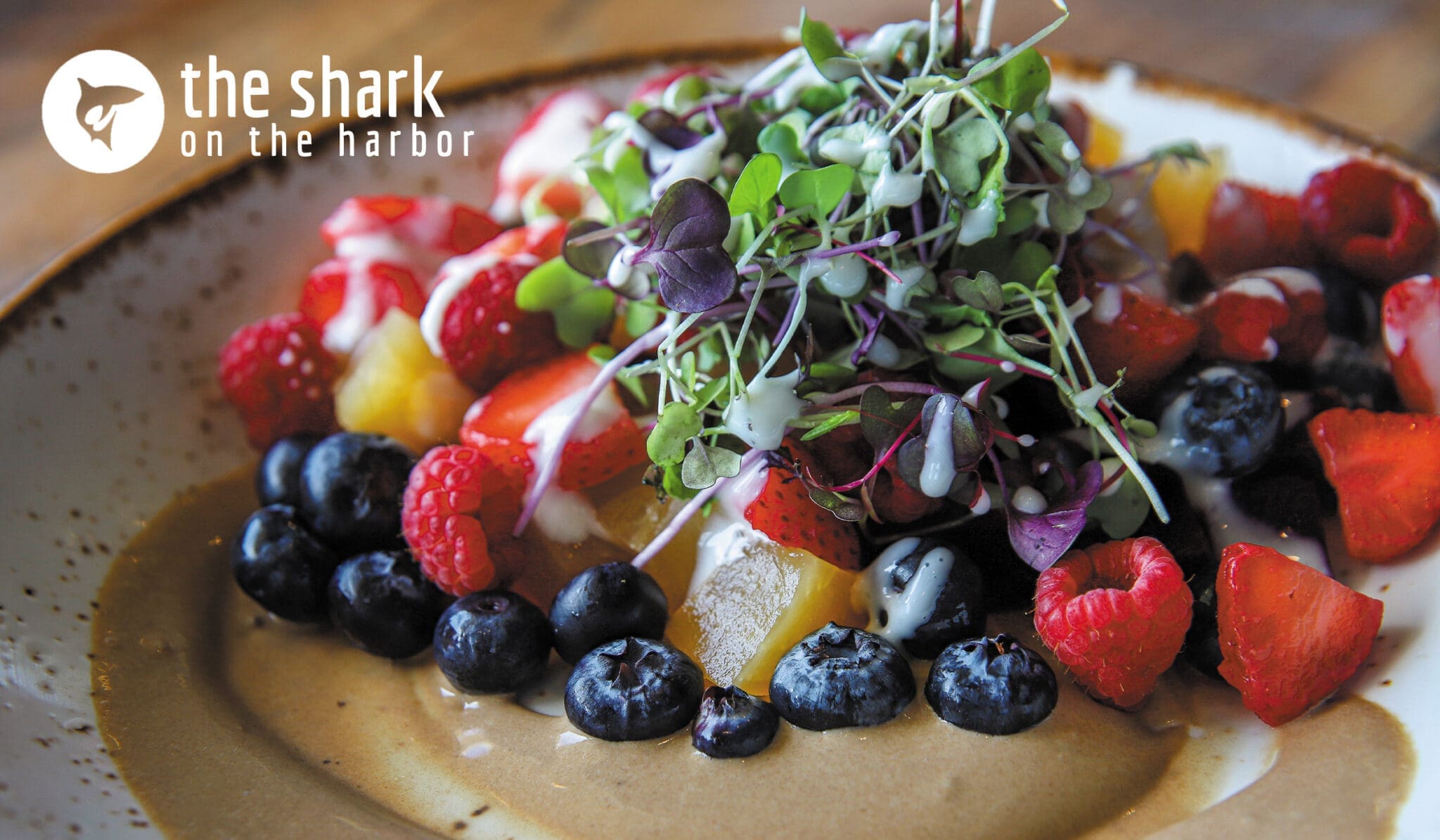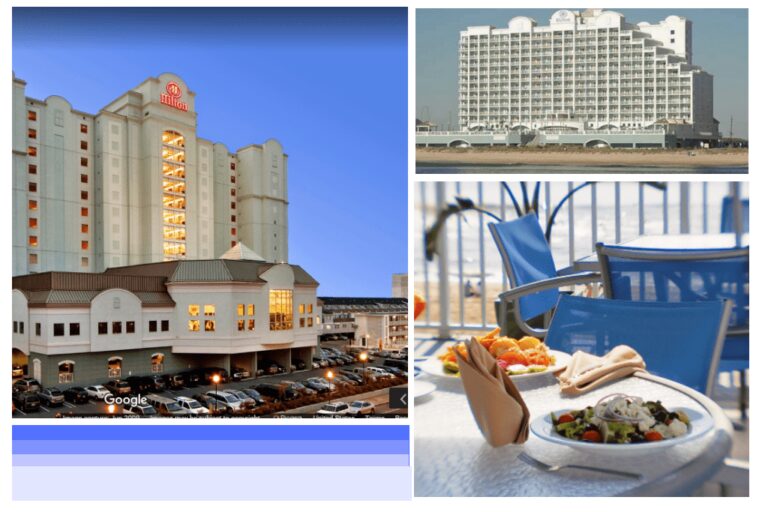A chef’s canvas is always in motion — from a cutting board, to a brine, a sauté pan, into the oven and finally — for public viewing — on the plate. Her pencils and brushes are knives and whisks. His clay and paint are the ingredients he uses. Meals created from area sourcing are genuine expressions of local art.
By Jody Kelly Wright, The Shark on the Harbor
By now, most people know the history of Ocean City as a fishing community. The commercial fishing harbor in West Ocean City remains one of the few working harbors along the East Coast. We’re fortunate to receive a large variety of fresh, local seafood arriving to the docks right by our back door — available for our community’s chefs to use.
Ocean City guests may not be aware of our thriving agricultural community. Jump started by the development of Quindocqua Farms in Marion Station, Maryland, the local farming scene is passionate, diverse and expanding. Separating themselves by growing methods, crop selection and location, each farm offers its own unique contribution to our community and to local chefs who partner with them in their creation of menu items. And, all of our prominent local farms grow all year round.
Regular sightings can be made of locally grown produce on area restaurant menus — in daily specials, and more abundantly from chefs who create rotating menus based on available seasonal ingredients. For these chefs, their artists’ medium is dictated in part by nature and enhanced by the craft and skill of our area growers.
Just as we’ve been honored with an extensive education in the seasonality of fish to our waters, Chef Travis and I have also learned about volumes of vegetables, greens and other produce that run rich in our sandy soil, thrive in our coastal climate and bring nutrients to our tables throughout the year. Once we committed to farm-to-table menu creation, our list of staples changed dramatically.
Even the term “produce” has taken on new meaning for us. What used to be thought of as primarily lettuce, tomatoes, peppers and onions has morphed into a long list of hearty greens, beans, roots, blossoms and fruits. Lettuce is the matriarch of the leaves, sitting back and fondly watching her grand babies, mustard and dandelion greens run the fields in play. When we take a moment and pay attention to what our ancestors knew about the nutritional value of crops and the seasons in which they naturally flourish, we realize that eating healthfully is easier than we thought if we simply let nature guide us.
In the beginning, this all seemed a little daunting, yet still exciting. Ten years ago, local growers were just dipping their toes in the waters of farming. We all jumped in together — paint brushes in hand, ready to create. Our initial partnerships with Lawrence (Quindocqua Farms, Marion Station, Md.) and Matt and Stefanie (Chesterfield Heirlooms, Pittsville, Md.) were and remain to be true gifts. They’ve allowed us to bear witness to their experiences, to sit in on their learning processes and to ride their waves of success and challenge as they’ve remained focused, committed and passionate about their products.
We dove in, prepared to take the daily bounty as it came — excited to await the deliveries and to partner with our talented team to create. High season was upon us, and the bushels of multiple varieties of tomatoes, peppers and squash vegetables arrived as expected — a seemingly endless supply, highlighted with juicy peaches and strawberries of early summer, followed by sweet watermelons and cantaloupes of summer prime. As the August heat turned to shorter days, less water and cooler nights, our deliveries reflected nature’s shift in focus. Her desire to keep us healthy throughout the colder months ahead steered our growers toward root vegetables and hearty greens.

One morning, Chef Travis and I arrived at work to find bushels of beautiful, bright and bold radishes. We looked at each other, then back to the radishes.
“What will you do with those?” I asked. “Garnish salads?” I wished for a bus load of salad eaters to join us that week.
“I don’t know yet,” he answered.
I felt wildly optimistic. Not really. But we had handed ourselves over to this day-to-day creation, and no one was more in favor of this decision than I was.
Later that day, I watched him at the computer. Multiple Google search windows open at once. Scratching notes on a small scrap of paper.
Hours later, or maybe the next day, he came to me with a bowl and a spoon.
“Taste this and tell me what you think.”
The consistency caught my eye first. Followed by its pale pink color.
“Did you put cream in this?” I asked. I wouldn’t have been against it if he had, but my desire to eat healthfully outweighed my interest in devouring food just to fill up.
“No.” He nudged the bowl closer to me. “Just eat it.”
I sipped the edge of the spoon. Delicate sweetness kissed my palate. The second bite closed with a buttery finish. Only the finest wine would have rivaled the layers of flavor and dimension of mouth feel.
“Did you add sugar?”
“No. Do you like it?” He questioned.
“I love it!” I answered, gripping the bowl as he reached for it.
“Good,” he answered, spinning around and heading back to the kitchen.
“Wait, what is this?” I asked, still clutching the spoon.
“Roasted radish soup.”
I felt a flurry of mixed emotions. First, who would have thought that radishes, of all things, would be naturally sweet and oh so creamy when roasted? And, who on earth would order a radish soup?
Thankfully, a few creative social media posts got the buzz rolling. Once a few guests tried that soup, it became one of our most sought-after dishes. It would have never been on our menu if Lawrence hadn’t dropped those bushels of radishes that morning.
Since then, our farmers have continued to surprise us with unique crops and new ideas. Today, they communicate in advance what they’re planning to harvest, and we plan accordingly. Some growers met with Chef Travis in advance of each season to discuss successes and failures of the previous year and to brainstorm the next set of plantings.
Matt and Stefanie Barfield of Chesterfield Heirlooms are an excellent example of this partnership. With a combined 35 years of diverse experience in the restaurant business, the Barfields have an intimate relationship with the industry, making their work with chefs a pleasure for all parties involved. They sell their products to nearly a dozen restaurants along the coast, from Berlin to West Ocean City and into Rehoboth Beach, Del.
Through the use of passively heated greenhouses, called high tunnels, Chesterfield has extended their growing season to 12 months a year. On a mid-April visit to their land, plants were thriving through all levels of growth — from germination through harvest.
Garlic chives grow wild around the entrances to their five high tunnels. The aroma lingers long enough that I can imagine them incorporated into a dish, and I immediately feel hungry.
An exquisite sense of peace lingers on the air in an environment where new life is happening at every turn — even in the compost pile — the place where everything ends and then begins again.
Matt explains that healthy soil will feed and nourish the plants, making them more resistant to pests and diseases. They achieve healthy, nutrient rich soil by planting cover crops and resting certain areas of their farm. They also use their compost pile to add nutrients to their soil.
He pulls a bundle of radishes from the ground, and we smile at their bright, multiple colors — one sign of an heirloom crop.

I asked Matt how he first became interested in farming, and, in his style, he answers with a smile.
“It all started with a gift of heirloom tomato seeds that my mom purchased from QVC. She said, you like food and you like history, so I thought these would be perfect for you.”
I smile back. Could she have had any idea where this gift would have led Matt and Stef?
Chesterfield Heirlooms now grows dozens of crops from heirlooms seeds sourced from all of the world. Their commitment to keeping this food heritage alive is admirable and important.
I will be forever grateful that Matt received that gift from his mom. Our mission in this industry is to create real food, from scratch — and to provide our guests with a unique dining experience that they wouldn’t have enjoyed anywhere else. With ingredients like those from Chesterfield Heirlooms to use as their clay and paint, our culinary team is set to prepare memorable works of art.
During service, each plate is passed through the window to the expeditor. On his side, freshly trimmed micro greens await their resting place as garnishes. Bursting with flavor, these sprouts take the place of dried herbs and ground spices used to finish plates in years past.
Once served, guests often ask to see the menu again. We enjoy watching them revisit the meal’s description, identifying individual ingredients and noting where they were sourced.
“Do you really get local produce all year round?” they ask.
And that’s my cue to tell them about Lawrence, and Matt and Stef, the guys at Terrapin Farms and also Baywater Farms. I could talk for hours. But I don’t. Because, they’re here to eat. Instead, I send them to the farmer’s markets, where they can meet our friends in person. And, I hope they go.
Jody Wright owns and operates The Shark on the Harbor in West Ocean City.















